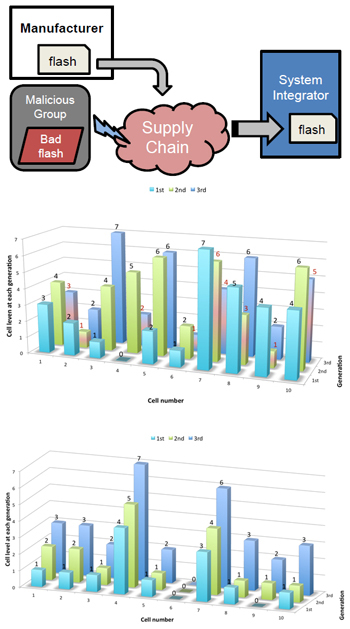|
Mitigating Variability in Solid-State Storage DevicesOur overall objective is to understand the variability present in solid-state storage devices and developing techniques to mitigate it based on application-level requirements. Toward this end we are characterizing a range of both solid-state drives and discrete flash devices and analytical techniques to understand their reliability behavior. The objectives for the next quarter are to collect and analyze preliminary SSD characterization data and begin devising error management approaches based on the discrete device data we have already collected. Publications: "Extracting Device Fingerprints from Flash Memory Exploiting Physical Variations," Pravin Prabhu, Ameen Akel, Laura Grupp, Wing-Key Yu, G. Edward Suh, Edwin Kan, and Steven Swanson. Proceedings of the 4th International Conference on Trust and Trustworthy Computing 2011, 06-22-11"Understanding the Impact of Power Loss on Flash Memory," Hung-Wei Tseng, Laura M. Grupp and Steven Swanson. 48th Design Automation Conference (DAC 2011), 06-06-11 "Coding Methods for Emerging Non-Volatile Memories," Lara Dolecek, UCLA. Information Theory and Applications Workshop 2011, 02-11-11 "LDPC Absorbing Sets, the Null Space of the Cycle Consistency Matrix, and Tanner's Constructions," Jiadong Wang, Lara Dolecek and Richard Wesel (all UCLA). Information Theory and Applications Workshop 2011, 02-07-11 Plans/Outlook: Our immediate goals are to widen the scope of our data collection to include additional SSDs and flash chips. We are also constructing several new hardware artifacts (simple boards) to help in power measurement and adapting our existing infrastructure to a wider range of flash devices.
(Top) Threat model for counterfeit detection, from 'Extracting Device Fingerprints from Flash Memory by Exploiting Physical Variations' (see Publications). (Middle) Benefits of new coding schemes when erase operation is costly. Here, naive scheme with randomly ordered operations. (Bottom) Proposed scheme where subsequent writes do not decrement cell value, thus avoiding costly erase operations (marked in red). Proposed scheme is simple to describe mathematically and optimal. Category: Measurement / Modeling Campus:
UCSD UCLA
People: PIs: Steven Swanson (UCSD), Lara Dolecek (UCLA); Graduate Students: Ryan Gabrys (UCLA), Laura Grupp, Pravin Prabhu, Hung-Wei Tseng (UCSD) Artifacts: We have amassed a significant amount of data on flash memory error patterns. It is not yet suitable for wider consumption (i.e., outside the expedition).
|
|
Mitigating Variability in Solid-State Storage Devices
|

